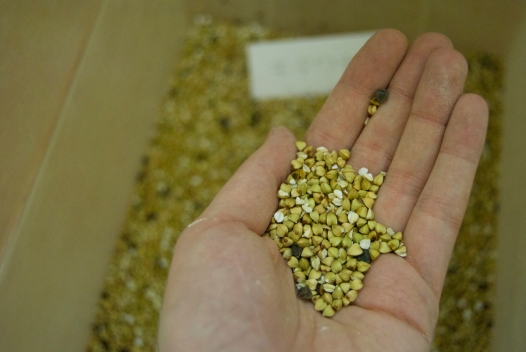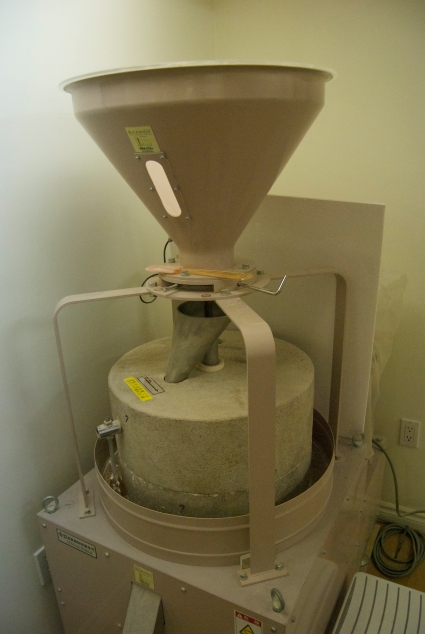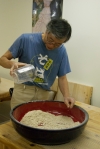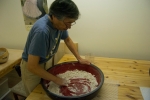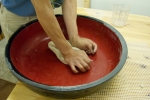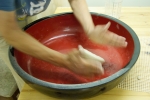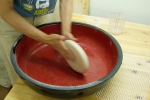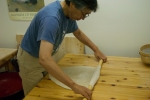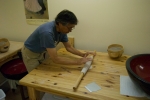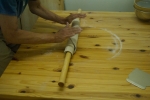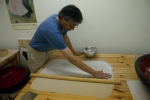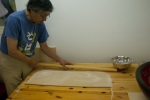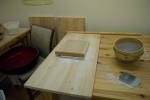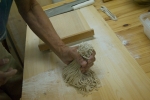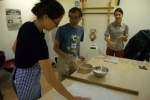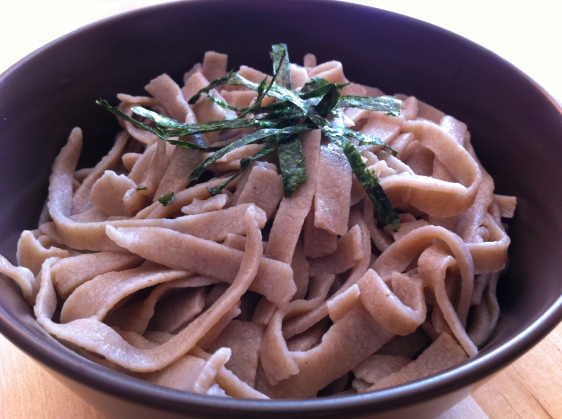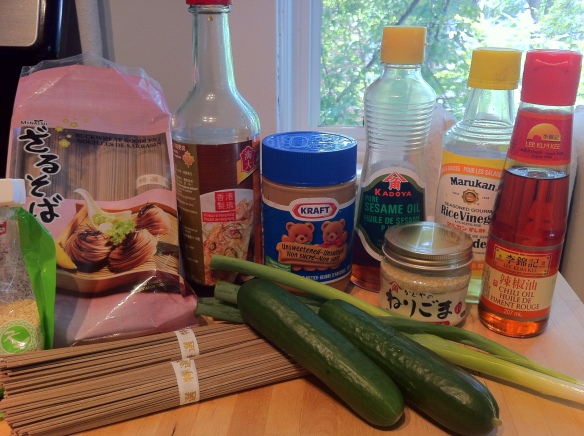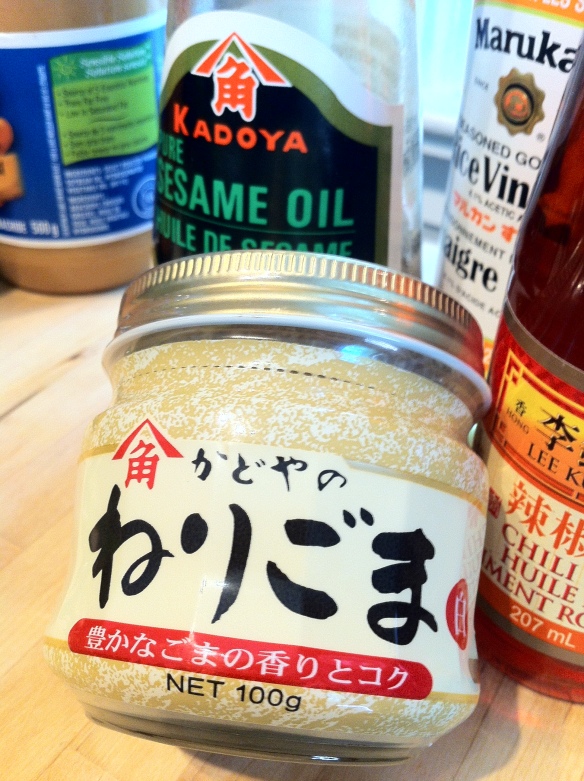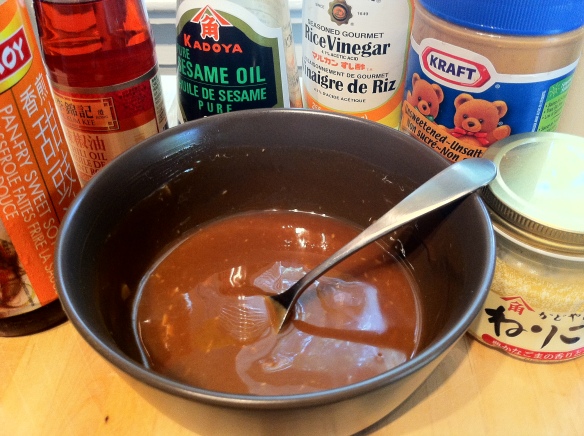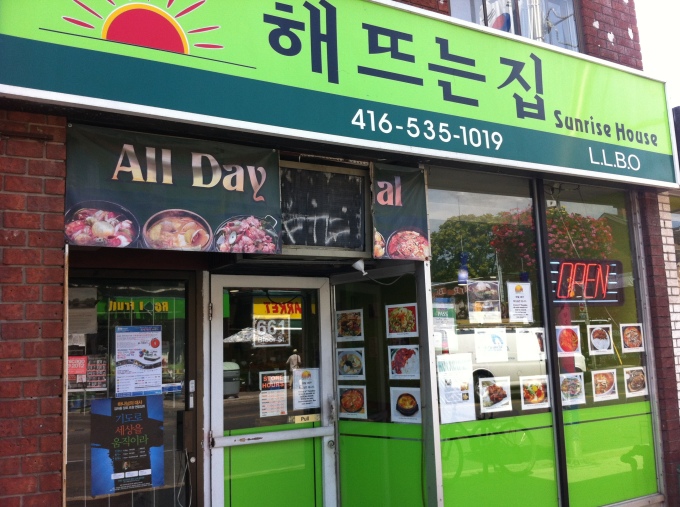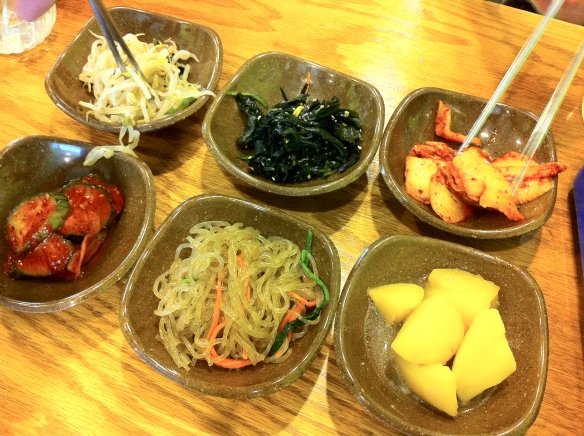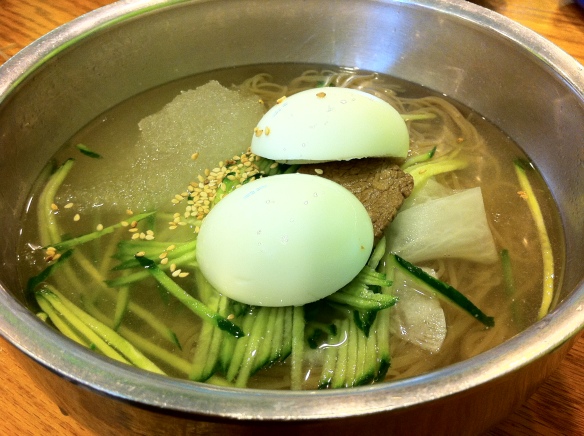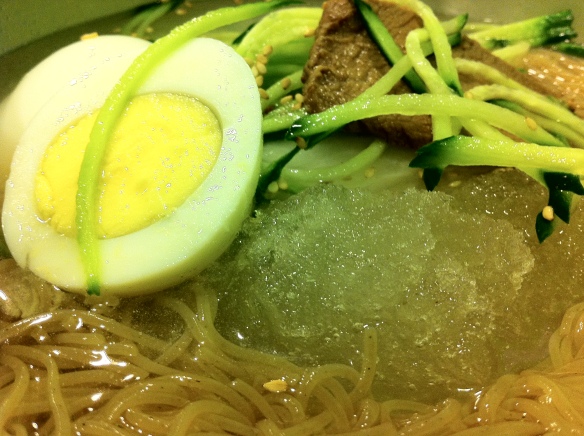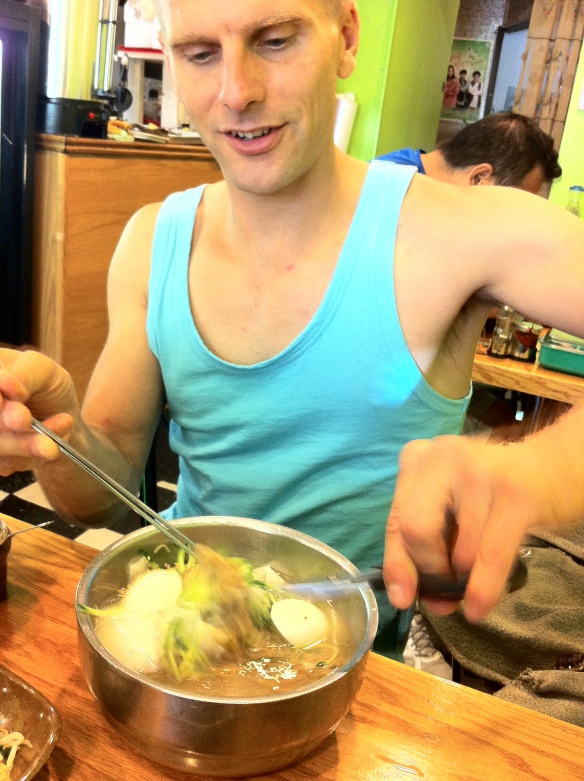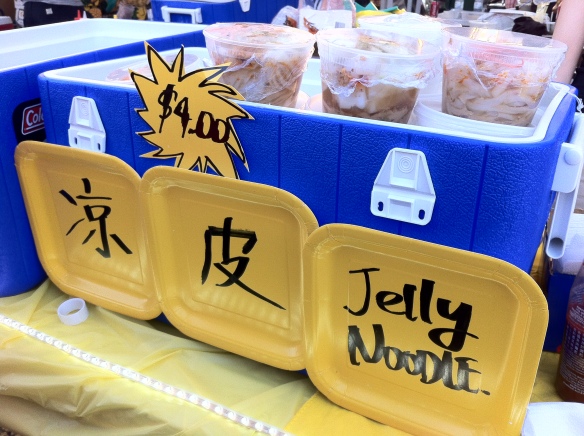Despite my many years of noodle obsession, I had never – until a couple weeks ago – tried my hand at actually making my own noodles from scratch. I don’t mean just frying up some noodles in a wok; I mean actually mixing a dough, rolling it out and cutting it into strands of noodles. I’ve seen it done many times in markets, restaurants and on television, have always been interested in the process, and briefly entertained the idea of making David Chang’s ramen recipe from the first issue of Lucky Peach. Alas, without any guidance or instruction, the task always proved too daunting to try on my own. So when my hobby-forward friend Laura (also my companion for last year’s woodworking class) proposed checking out a soba noodle making class (after being inspired by the soba noodles in sesame sauce that I brought to her bbq!) with our friends Ananda and Julia, I was all in.
Soba is a traditional Japanese noodle made from buckwheat flour that’s lauded not only for its delicate flavour but also its health benefits. It’s extremely popular across Japan and can be found in a wide range of eateries, from tiny train station noodle stands, to mid-level tourist spots to expensive restaurants specializing exclusively in soba. Soba quality can vary greatly though, and the base factor in that is whether the soba is fresh and handmade or dried and machine-made. It’s kind of like the difference between fresh and dried pasta – the fresh stuff tastes way better. Interestingly, however, only a tiny fraction of soba purveyors in Japan actually make fresh soba by hand. This is because the fresh stuff is quite labour intensive and requires a significant amount of skill and expertise – during the Edo period, aspiring soba masters apprenticed for a total of 5 years and 3 months!
 Fresh soba contains approximately 80% buckwheat flour – this high buckwheat content is what gives the fresh noodles their prized flavour but it’s also what makes them tricky to produce. Buckwheat flour lacks gluten, the protein that’s responsible for giving dough its elasticity (that’s why those gluten-free cookies and cakes are always kinda crumbly). So when buckwheat flour is mixed with water, the resulting dough is quite delicate and prone to breaking. Machines just can’t make noodles from that kind of inelastic dough, so they cheat by using only about 40% buckwheat flour mixed with regular wheat flour. The noodles are then typically dried and packaged, to be consumed later. The large majority of soba in Japan and abroad is of this dried variety. And while it obviously has the appeal of convenience and efficiency, it comes at the cost of that delicate buckwheat taste. For the soba connoisseurs then, real soba is only the fresh stuff.
Fresh soba contains approximately 80% buckwheat flour – this high buckwheat content is what gives the fresh noodles their prized flavour but it’s also what makes them tricky to produce. Buckwheat flour lacks gluten, the protein that’s responsible for giving dough its elasticity (that’s why those gluten-free cookies and cakes are always kinda crumbly). So when buckwheat flour is mixed with water, the resulting dough is quite delicate and prone to breaking. Machines just can’t make noodles from that kind of inelastic dough, so they cheat by using only about 40% buckwheat flour mixed with regular wheat flour. The noodles are then typically dried and packaged, to be consumed later. The large majority of soba in Japan and abroad is of this dried variety. And while it obviously has the appeal of convenience and efficiency, it comes at the cost of that delicate buckwheat taste. For the soba connoisseurs then, real soba is only the fresh stuff.
Enter Ted, our noodle-making host for the afternoon and the only person to his knowledge IN CANADA making fresh soba by hand. Ted hails from the Asakusa district of Tokyo, one of the city’s few neighbourhoods where you can see and feel traditional elements of the foregone Edo period. After spending many years as the boss of a company in Japan, which included a brief stint in Toronto, Ted gave up the corporate world in favour of the noodle world (my hero!). Having always been a big soba fan, he went to school in Japan to learn the craft of soba making. Then, lucky for us, he brought his skills back to Toronto and through his company, Soba Canada, has been spreading the soba love here for over 15 years. He hosts a weekly event called Soba Tuesdays where he takes over Ichiriki Japanese restaurant at Yonge and Bloor for a night and, instead of the restaurant’s regular sushi menu, he offers a special soba menu consisting exclusively of fresh noodles that he’s personally made from scratch. In addition, he occasionally hosts soba-making classes in his basement workshop.

The zaru soba (i.e. chilled soba on bamboo sieve with dipping sauce) that I enjoyed at Soba Tuesday about a year ago, served with sides of fresh tofu, crab legs and salmon roe
Ted is the definition of an artisanal food maker, without any of the pretension, puffed-up marketing or overpricing ($10 for an artisanal chocolate bar anyone?) that usually goes along with the Brooklyn-inspired food trend that’s taken over North America these days. You want farm-to-table? He’ll literally give you seed-to-table. For Ted, the single most important factor in making delicious soba is the quality of the flour – even a soba master’s noodles wouldn’t taste good if using low quality stuff. Unsatisfied with the quality of buckwheat flour that’s available in Canada, Ted makes his own, and is involved in every single step of its production. He uses parent seeds from Japan which are then planted on a farm in Manitoba, the “buckwheat capital of Canada” (interestingly, Canada doesn’t consume much buckwheat itself and most of Manitoba’s production is exported to Japan; Japan on the other hand is a top buckwheat consumer but doesn’t produce much of the crop itself due to space). When the crop is harvested, he takes the buckwheat seeds back to his home in Mississauga and grinds them into a flour himself, using a flour mill that he has in his basement workshop. He packages and sells some of the flour for retail. But when preparing a fresh batch of noodles to serve, he’ll actually grind the flour fresh that morning.
In addition to the level of care that’s put into producing the buckwheat flour, the process of actually making the noodles is a whole craft in itself. As I mentioned before, aspiring soba masters would spend 5 years and 3 months learning the art of soba making – 3 years for mixing the dough by hand, 2 years for rolling the dough and 3 months for cutting the dough into strands. While those days of intense apprenticeship are long gone, it still takes a significant amount of time and practice. For example, Ted offers a 20-day intensive course for aspiring soba professionals. Setting our sights a little lower, we opted for Ted’s one-day experience class – you watch Ted’s demonstration of noodle-making, and then he helps out as you make a batch of noodles on your own to take home. With just a couple hours of instruction, you’re not able to actually acquire and retain the skills to make soba independently. But just taking part in the process for a day is so much fun. Also, it’s pretty inspiring to watch and learn from someone who is so passionate and expertly skilled at their craft. Watching Ted’s demonstration, I was completely in awe. Total control and fluidity in his movements, as the buckwheat flour gradually transformed through each step of the noodle-making process, from small balls of dough to their ultimate incarnation as fine buckwheat strands. Kind of hard to describe in words, you can see the entire process below (click on an image, and a carousel of photos will pop up):
- Lacquered wooden kibachi bowls from Japan, for mixing and kneading soba dough
- Precisely measuring out the flour
- Sifting the flour
- Gradually adding the water in small increments – every drop will make a difference in the texture of the dough
- Mixing – fast, fast, fast
- And mixing
- And mixing
- Bringing it all together
- Kneading
- Slapping and shaping
- A giant hershey kiss
- Forming it into a circle
- Rolling
- Rolling
- Flouring up
- The circle of dough is wrapped around the rolling pin and then lightly tapped and rolled to stretch it out – the goal is to eventually turn the circle into a square
- Laying it out
- Rolling and tapping
- And laying it out
- And rolling and tapping
- And laying it out – it’s a square!
- Rolling it out some more – making it thinner
- Spreading the flour
- Folding the dough over
- More folding
- Flouring the cutting board
- A special wood block is placed on top of the dough – it will act as a ruler, guiding the knife that cuts the noodle strands
- The knife/cleaver
- Cutting the noodles into fine strands
- The cutting takes a balanced combination of pressure, motion and speed
- Shaking out the flour
- A handful of finished noodles
- The final product!
- Our turn – Laura measuring out her flour
- Ted giving Julia some tips on rolling
- Rolling
- Proud soba student
- Thanks Ted!
It’s so much harder than it looks! Thanks to Ted’s guidance, I think we did pretty well for total novices. My soba turned out pretty ugly though – I couldn’t roll the dough out thin enough, so my noodles turned out pretty short and I also couldn’t manage that giant knife too well, so they were thick as well. But they still tasted really good! In line with his focus on freshness, Ted told us that to experience the best taste, the noodles must be prepared and eaten within 3 days maximum, although first or second day soba is best – even Ted’s dog Cookie, evidently a trained soba connoisseur, won’t eat third day soba. I made my noodles the next morning, preparing them in the traditional zarusoba method- quickly boiled and then chilled, garnished with some roasted seaweed and fresh green onions and served cold with a tsuyu dipping sauce on the side (the sauce is flavoured with dried bonito flakes, soy and mirin; I just bought a bottle at the Korean grocery store on Bloor). You’re supposed to just pick up some noodles with your chopsticks, dip them in the sauce and slurp away. You could really taste the difference from using fresh handmade noodles. Mmm soba – so good.


